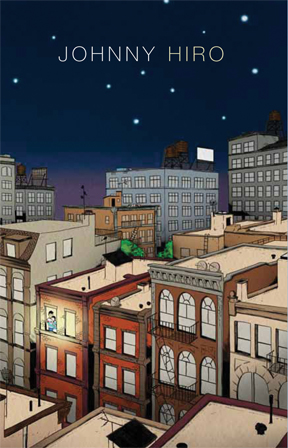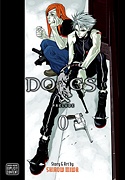This week’s ComicList is kind of lean, so I’ll focus on one particular release. It’s Karuho Shiina’s Kimi ni Todoke: From Me to You (Viz), and it’s hilarious and delightful.
 You remember that girl who crawled out of the well in The Ring, right? Sawako Kuronuma bears an uncanny resemblance to that creepy character, and the coincidence hasn’t escaped her classmates’ notice. Sawako is a sweet, optimistic girl, but her spooky, slump-shouldered bearing is completely at odds with what’s inside. Remember that bit in Addams Family Values when Wednesday tried to smile? It’s like that, except that Sawako is really trying to be genial.
You remember that girl who crawled out of the well in The Ring, right? Sawako Kuronuma bears an uncanny resemblance to that creepy character, and the coincidence hasn’t escaped her classmates’ notice. Sawako is a sweet, optimistic girl, but her spooky, slump-shouldered bearing is completely at odds with what’s inside. Remember that bit in Addams Family Values when Wednesday tried to smile? It’s like that, except that Sawako is really trying to be genial.
As high-school students are a cowardly and superstitious lot, rumors fly about Sawako. They think she communes with ghosts and can curse those around her. Even the teachers are wary of her. Hell, even puppies get skittish in her presence. It probably doesn’t help that the kanji that constitute her family name also translate into “black swamp.”
So Sawako takes it upon herself to try and clear up what she believes to be simple misunderstandings. She meets with limited success until Kazehaya, the most popular boy in class, starts treating her with the same cheerful courtesy he extends to everyone. The tide begins to turn for Sawako, and she starts making other friends. And while she still looks and acts like she crawled out of a well, she’s sparkling with happiness on the inside.
It’s that disconnect – Sawako’s frightening mien wrapped around the open heart of a true shôjo princess – that makes the book so funny and endearing. Also delightful is the fact that Sawako never once entertains the notion of changing her appearance; she just wants to introduce her classmates to the girl on the inside. Shiina has a real gift for constructing scenarios that allow you can to root for Sawako and still giggle at the ways her efforts can backfire. Shiina’s illustrations hit all the right notes, from funny-creepy to sparkly-sweet, sometimes in the same panel.
Kimi ni Todoke is off to a wonderful start. It’s a great look at an offbeat kid trying to find happiness on her terms. Sawako is undeniably naïve, but she’s naïve in the best possible way. She believes the best of people, that they’ll accept truth and overlook appearance. And Shiina lets her be right often enough to balance out the laughs that come from the moments when Sawako is wrong.
(This review is based on a complimentary copy provided by the publisher.)
 Johnny and Mayumi are young, in love, and living in New York City. That means they work too hard, live in a kind of crappy apartment, and never seem to have enough money at the end of the month. But they have each other and all of the affection, support and loyalty one could hope for; they also have cats. Those things go a long way to compensate for the overworked, underpaid grind.
Johnny and Mayumi are young, in love, and living in New York City. That means they work too hard, live in a kind of crappy apartment, and never seem to have enough money at the end of the month. But they have each other and all of the affection, support and loyalty one could hope for; they also have cats. Those things go a long way to compensate for the overworked, underpaid grind.
 That isn’t to suggest that Miwa’s milieu is a pleasant one. The book’s linked short stories are set in a futuristic dystopia full of sometimes terrible people doing what they need to do to get by. Like all good noir casts, the characters all have dark and painful secrets to tote around as they navigate these murky waters. Fortunately, Miwa doesn’t seem inclined to dwell. He doesn’t exactly minimize the suffering on display, but he doesn’t put it on a pedestal either.
That isn’t to suggest that Miwa’s milieu is a pleasant one. The book’s linked short stories are set in a futuristic dystopia full of sometimes terrible people doing what they need to do to get by. Like all good noir casts, the characters all have dark and painful secrets to tote around as they navigate these murky waters. Fortunately, Miwa doesn’t seem inclined to dwell. He doesn’t exactly minimize the suffering on display, but he doesn’t put it on a pedestal either. I was largely unmoved by the tale of Naoto, the young girl raised to be a killer by the man she believes murdered her parents. It’s in that segment that Miwa comes closest to flat, straight-faced noir, and while it’s executed well, it lacks the dollops of quirky, what-the-hell humor that characterize the rest of the book.
I was largely unmoved by the tale of Naoto, the young girl raised to be a killer by the man she believes murdered her parents. It’s in that segment that Miwa comes closest to flat, straight-faced noir, and while it’s executed well, it lacks the dollops of quirky, what-the-hell humor that characterize the rest of the book. I can’t bring myself to skim when I’m reading for pleasure. If the book is awful enough, I’ll abandon it entirely, but if it doesn’t hit that threshold, I feel compelled to read every word. This can be a problem. It certainly was when I was reading CLAMP’s
I can’t bring myself to skim when I’m reading for pleasure. If the book is awful enough, I’ll abandon it entirely, but if it doesn’t hit that threshold, I feel compelled to read every word. This can be a problem. It certainly was when I was reading CLAMP’s  These are the lyrics of one of the lynchpin characters, a chanteuse whose untimely death did not, unfortunately, take her songs with her. They’re portrayed as so moving that even isolated psychics can be stricken by their beauty, but I was reminded of the reject pile from my high-school literary magazine.
These are the lyrics of one of the lynchpin characters, a chanteuse whose untimely death did not, unfortunately, take her songs with her. They’re portrayed as so moving that even isolated psychics can be stricken by their beauty, but I was reminded of the reject pile from my high-school literary magazine. Well, okay, it kind of sings when you open it, because the illustrations are very, very beautiful. The four members of CLAMP trade duties, and Clover was drawn by Mokona with assistance from Tsubaki Nekoi and Satsuki Igarashi, with story by Nanase Ohkawa. What’s most striking to me is the use of negative space. Backgrounds are rather scant; panels float on fields of white and black, creating a precision of emotional effect. It also highlights the elegance, verging on sensuality, of the juxtaposition of the panels.
Well, okay, it kind of sings when you open it, because the illustrations are very, very beautiful. The four members of CLAMP trade duties, and Clover was drawn by Mokona with assistance from Tsubaki Nekoi and Satsuki Igarashi, with story by Nanase Ohkawa. What’s most striking to me is the use of negative space. Backgrounds are rather scant; panels float on fields of white and black, creating a precision of emotional effect. It also highlights the elegance, verging on sensuality, of the juxtaposition of the panels.
 Fortunately, the sampler also includes some pages of Banri Hidaka’s
Fortunately, the sampler also includes some pages of Banri Hidaka’s  The thing I like best about Astral Project (CMX) is that it’s only kind of about any of the things it’s purportedly about.
The thing I like best about Astral Project (CMX) is that it’s only kind of about any of the things it’s purportedly about.  Trying to review a new installment of
Trying to review a new installment of  Zombies Calling owed a fair bit to Scream for its humor and structure, and Ellsmere seems to be similarly sourced. Like good-hearted grind Rory from the early years of The Gilmore Girls, Ellsmere’s Juniper wins enrollment into a prestigious private school (via scholarship instead of grandparental largesse, in Jun’s case) and immediately draws the threatened attention of the institution’s self-appointed queen bee. On Gilmore, that queen bee was the highly strung overachiever Paris Gellar; in Ellsmere, it’s the smirking, vicious Emily,
Zombies Calling owed a fair bit to Scream for its humor and structure, and Ellsmere seems to be similarly sourced. Like good-hearted grind Rory from the early years of The Gilmore Girls, Ellsmere’s Juniper wins enrollment into a prestigious private school (via scholarship instead of grandparental largesse, in Jun’s case) and immediately draws the threatened attention of the institution’s self-appointed queen bee. On Gilmore, that queen bee was the highly strung overachiever Paris Gellar; in Ellsmere, it’s the smirking, vicious Emily, The quantity of choices lets me be picky, too. I tend to avoid procedurals that make me endure a bunch of subplot drama about the investigators. I have a very “Get back to work” attitude towards forensic scientists, detectives and their ilk. (The original Law & Order is usually perfect for this. The only times we find out anything about a character’s personal life is when they’re about to leave, which only happens every couple of years. On the flip side, I haven’t read a Patricia Cornwell novel in years because of all the intolerable whining. Solve something, for pity’s sake.)
The quantity of choices lets me be picky, too. I tend to avoid procedurals that make me endure a bunch of subplot drama about the investigators. I have a very “Get back to work” attitude towards forensic scientists, detectives and their ilk. (The original Law & Order is usually perfect for this. The only times we find out anything about a character’s personal life is when they’re about to leave, which only happens every couple of years. On the flip side, I haven’t read a Patricia Cornwell novel in years because of all the intolerable whining. Solve something, for pity’s sake.) Anyway, for those of you who aren’t familiar with the series, it’s a sort of “best of” sampler of a long-running, much-loved culinary manga. Viz is publishing the A la Carte collections, which focus on a particular aspect of cuisine. In this case, it’s sake and some lesser beverages, like champagne.
Anyway, for those of you who aren’t familiar with the series, it’s a sort of “best of” sampler of a long-running, much-loved culinary manga. Viz is publishing the A la Carte collections, which focus on a particular aspect of cuisine. In this case, it’s sake and some lesser beverages, like champagne.